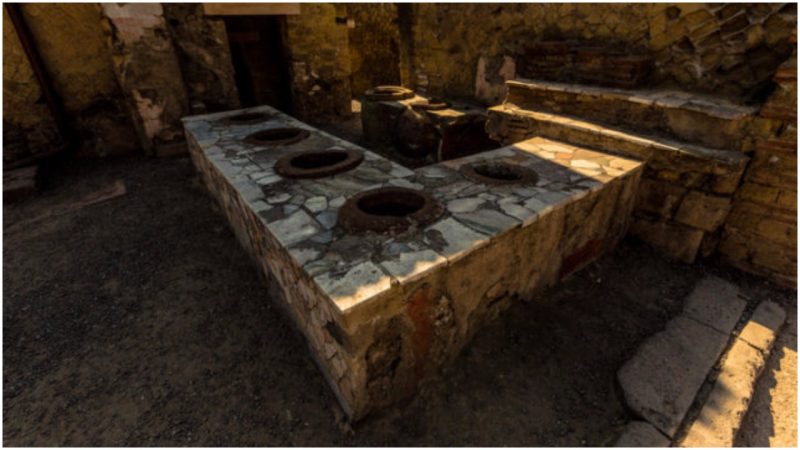In an era where applications penetrate into every single sphere of human life, ordering take-out food seems to be the easiest thing to do. One click of a button is just enough for you to order food from the comfort of your home and have it delivered straight to your door in a matter of minutes.
In modern times, the way we buy and cook food has been revolutionized in accordance with the newest technologies and advances, and it’s safe to say that this is probably the most exciting era to be a foodie. But was it possible to get take-out food in ancient times?
While we tend to think of take-out food as having originated in the modern era as a result of our “too busy to prepare my own meal” lifestyle, the truth is quite the opposite. As a matter of fact, hundreds of years ago, citizens of Ancient Rome could also buy pre-prepared hot food.
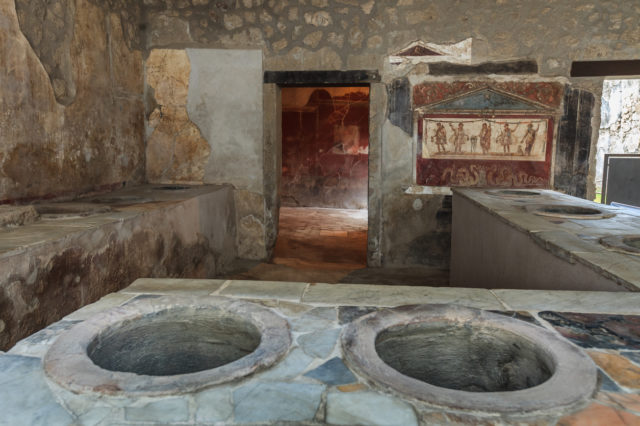
Now, for a moment imagine yourself living in Ancient Rome. After a long day of debates in the Senate, trying to convince your colleagues that denying the requests of the Cimbri and Teutones for land along the Rhine might not be such a clever idea, all you need is a good meal and that it’s exactly what your servants have prepared for you: A nice starter and then, of course, some roasted meat followed by various fruits or nuts.
But what if you were one of the poor citizens of Ancient Rome and couldn’t afford the luxury of having a private kitchen in your home? In Ancient Rome it was highly uncommon for poor people to cook at home and many of them would take their food to the baker who would then cook it in the oven. The other, more common option was to purchase food from the local thermopolium.
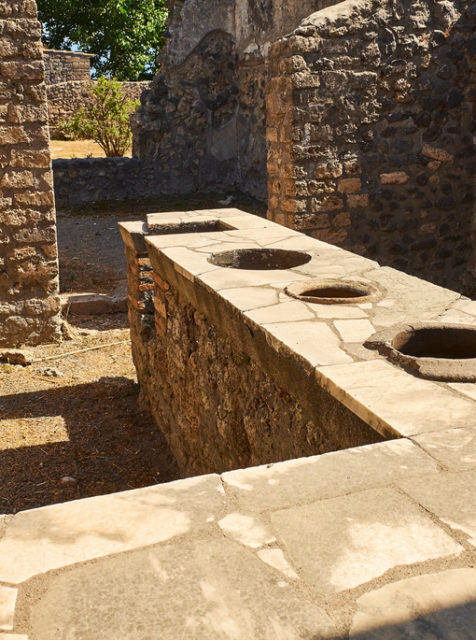
The thermopolium was an ancient form of a take-out restaurant, an outdoor service counter that offered ready to eat food. The word thermopolium literally means “a place where something hot is sold.”
It is thanks to a tragic event that occurred in 79 A.D. that we now know many details about the diet of Ancient Romans and the existence of thermopolia. One fateful day in August of that year, an eruption wiped out the entire city of Pompeii, leaving its citizens, and let’s say the entire social life of Pompeii, entombed in ash for centuries until excavations of the site began some 1,700 years later.
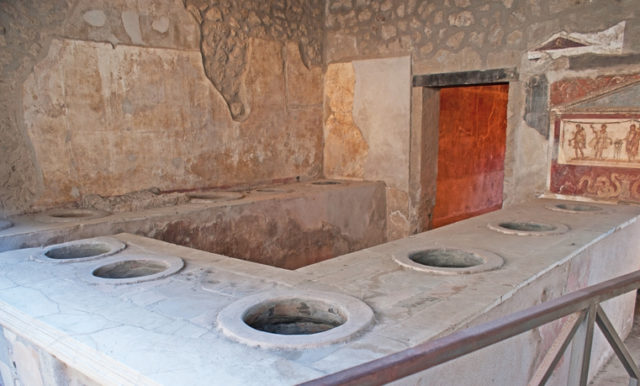
From what it was discovered, we now know that there were around 150 of these Ancient Roman fast-food establishments throughout the city of Pompeii. Poor citizens of Pompeii could order some of the ready-to-eat specialties of the era, which most likely included a sort of tomato-free pizza (tomatoes were not yet brought to Europe at the time) made of cheese and onions, soups, pickles, eggs, fish, ham, and of course wine.
When it comes to the architectural design of a typical thermopolium, excavations in Pompeii revealed that most of these ancient fast-food joints usually consisted of a small room with a stone counter at the front, in which several terracotta jars called Dolia were placed.
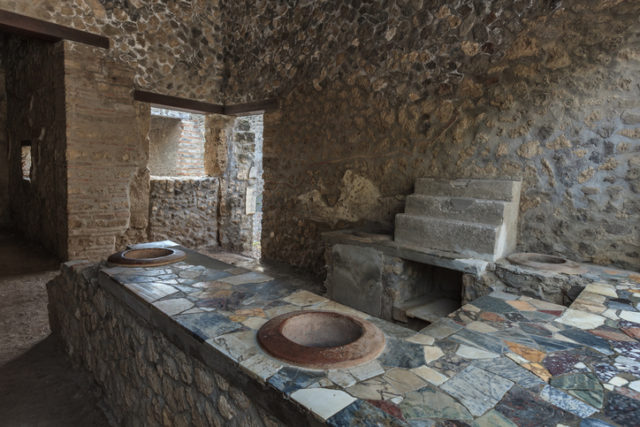
Mary Beard, a classics professor at Cambridge University, who authored The Fires of Vesuvius: Pompeii Lost and Found, describes the concept of take-out food in the city of Pompeii:
“The best way to escape a diet of bread, cheese and fruit, eaten in small lodginggs over a shop or workshop, where there were limited or no facilities for cooking anything more interesting, was to eat out. Pompeii has long been thought of as a cheap café culture, with bars, taverns and thermopolia (as they are often called in modern guidebooks, though this was certainly not the standard ancient term) lining the streets, catching the passing trade—from visitors with time on their hands to local residents with nowhere nice of their own to be. In fact the masonry counters facing the pavements, with large jars (dolia) set into them and display stands behind, are one of the most familiar elements of in the Pompeian street scene.”
The Dolia were rarely used for storing hot food as the process of cleaning them would have been quite awkward afterwards. Instead, they were mostly used for storing dried food like nuts.
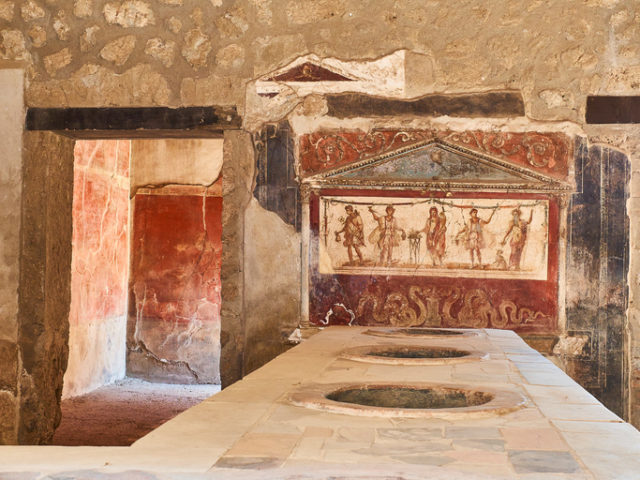
Over the years, archaeologists have discovered a number of thermpolia not just in Pompeii but also in Herculaneum, as this town was also destroyed (and preserved) by the eruption of Mount Vesuvius.
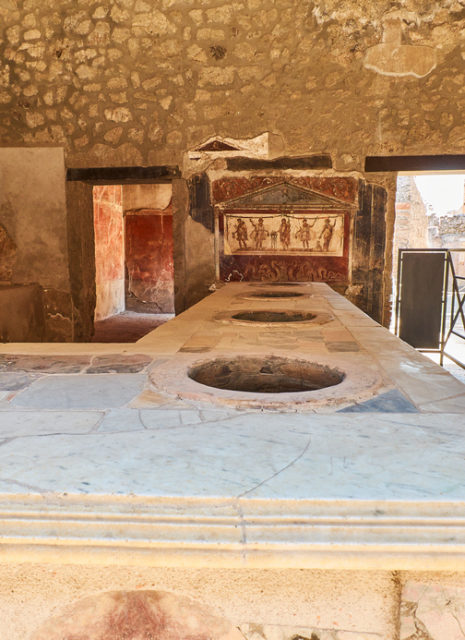
In one thermopolium, the remains of a cloth bag containing around a thousand coins was discovered in one of the dolia; this almost certainly demonstrates the popularity of the establishment.
One of the best examples of this kind of establishment in Pompei is The Thermpolium of Asellina, which was discovered with complete jugs and dishes on the counter, along with a kettle filled with water.
